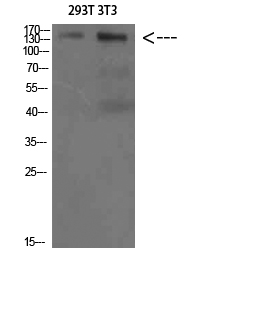AMBRA1 Polyclonal Antibody
- SPECIFICATION
- CITATIONS
- PROTOCOLS
- BACKGROUND

Application
| WB |
|---|---|
| Primary Accession | Q9C0C7 |
| Reactivity | Human, Mouse |
| Host | Rabbit |
| Clonality | Polyclonal |
| Calculated MW | 142507 Da |
| Gene ID | 55626 |
|---|---|
| Other Names | autophagy/beclin-1 regulator 1 |
| Dilution | WB~~WB 1:500-2000, ELISA 1:10000-20000 |
| Format | Liquid in PBS containing 50% glycerol, 0.5% BSA and 0.09% (W/V) sodium azide. |
| Storage Conditions | -20℃ |
| Name | AMBRA1 {ECO:0000303|PubMed:17589504, ECO:0000312|HGNC:HGNC:25990} |
|---|---|
| Function | Substrate-recognition component of a DCX (DDB1-CUL4-X-box) E3 ubiquitin-protein ligase complex involved in cell cycle control and autophagy (PubMed:20921139, PubMed:23524951, PubMed:24587252, PubMed:32333458, PubMed:33854232, PubMed:33854235, PubMed:33854239). The DCX(AMBRA1) complex specifically mediates the polyubiquitination of target proteins such as BECN1, CCND1, CCND2, CCND3, ELOC and ULK1 (PubMed:23524951, PubMed:33854232, PubMed:33854235, PubMed:33854239). Acts as an upstream master regulator of the transition from G1 to S cell phase: AMBRA1 specifically recognizes and binds phosphorylated cyclin-D (CCND1, CCND2 and CCND3), leading to cyclin-D ubiquitination by the DCX(AMBRA1) complex and subsequent degradation (PubMed:33854232, PubMed:33854235, PubMed:33854239). By controlling the transition from G1 to S phase and cyclin-D degradation, AMBRA1 acts as a tumor suppressor that promotes genomic integrity during DNA replication and counteracts developmental abnormalities and tumor growth (PubMed:33854232, PubMed:33854235, PubMed:33854239). AMBRA1 also regulates the cell cycle by promoting MYC dephosphorylation and degradation independently of the DCX(AMBRA1) complex: acts via interaction with the catalytic subunit of protein phosphatase 2A (PPP2CA), which enhances interaction between PPP2CA and MYC, leading to MYC dephosphorylation and degradation (PubMed:25438055, PubMed:25803737). Acts as a regulator of Cul5-RING (CRL5) E3 ubiquitin- protein ligase complexes by mediating ubiquitination and degradation of Elongin-C (ELOC) component of CRL5 complexes (PubMed:25499913, PubMed:30166453). Acts as a key regulator of autophagy by modulating the BECN1-PIK3C3 complex: controls protein turnover during neuronal development, and regulates normal cell survival and proliferation (PubMed:21358617). In normal conditions, AMBRA1 is tethered to the cytoskeleton via interaction with dyneins DYNLL1 and DYNLL2 (PubMed:20921139). Upon autophagy induction, AMBRA1 is released from the cytoskeletal docking site to induce autophagosome nucleation by mediating ubiquitination of proteins involved in autophagy (PubMed:20921139). The DCX(AMBRA1) complex mediates 'Lys-63'-linked ubiquitination of BECN1, increasing the association between BECN1 and PIK3C3 to promote PIK3C3 activity (By similarity). In collaboration with TRAF6, AMBRA1 mediates 'Lys-63'-linked ubiquitination of ULK1 following autophagy induction, promoting ULK1 stability and kinase activity (PubMed:23524951). Also activates ULK1 via interaction with TRIM32: TRIM32 stimulates ULK1 through unanchored 'Lys-63'-linked polyubiquitin chains (PubMed:31123703). Also acts as an activator of mitophagy via interaction with PRKN and LC3 proteins (MAP1LC3A, MAP1LC3B or MAP1LC3C); possibly by bringing damaged mitochondria onto autophagosomes (PubMed:21753002, PubMed:25215947). Also activates mitophagy by acting as a cofactor for HUWE1; acts by promoting HUWE1- mediated ubiquitination of MFN2 (PubMed:30217973). AMBRA1 is also involved in regulatory T-cells (Treg) differentiation by promoting FOXO3 dephosphorylation independently of the DCX(AMBRA1) complex: acts via interaction with PPP2CA, which enhances interaction between PPP2CA and FOXO3, leading to FOXO3 dephosphorylation and stabilization (PubMed:30513302). May act as a regulator of intracellular trafficking, regulating the localization of active PTK2/FAK and SRC (By similarity). Also involved in transcription regulation by acting as a scaffold for protein complexes at chromatin (By similarity). |
| Cellular Location | Endoplasmic reticulum. Cytoplasm, cytoskeleton. Cytoplasmic vesicle, autophagosome {ECO:0000250|UniProtKB:A2AH22}. Mitochondrion. Cytoplasm, cytosol {ECO:0000250|UniProtKB:A2AH22}. Nucleus. Cell junction, focal adhesion {ECO:0000250|UniProtKB:A2AH22}. Note=Localizes to the cytoskeleton in absence of autophagy induction (PubMed:20921139). Upon autophagy induction, AMBRA1 relocalizes to the endoplasmic reticulum to enable autophagosome nucleation (PubMed:20921139). Partially localizes at mitochondria in normal conditions (PubMed:21358617). Also localizes to discrete punctae along the ciliary axoneme (By similarity) {ECO:0000250|UniProtKB:A2AH22, ECO:0000269|PubMed:20921139, ECO:0000269|PubMed:21358617} |

Thousands of laboratories across the world have published research that depended on the performance of antibodies from Abcepta to advance their research. Check out links to articles that cite our products in major peer-reviewed journals, organized by research category.
info@abcepta.com, and receive a free "I Love Antibodies" mug.
Provided below are standard protocols that you may find useful for product applications.
Background
Regulates autophagy and development of the nervous system. Involved in autophagy in controlling protein turnover during neuronal development, and in regulating normal cell survival and proliferation (By similarity).
If you have used an Abcepta product and would like to share how it has performed, please click on the "Submit Review" button and provide the requested information. Our staff will examine and post your review and contact you if needed.
If you have any additional inquiries please email technical services at tech@abcepta.com.













 Foundational characteristics of cancer include proliferation, angiogenesis, migration, evasion of apoptosis, and cellular immortality. Find key markers for these cellular processes and antibodies to detect them.
Foundational characteristics of cancer include proliferation, angiogenesis, migration, evasion of apoptosis, and cellular immortality. Find key markers for these cellular processes and antibodies to detect them. The SUMOplot™ Analysis Program predicts and scores sumoylation sites in your protein. SUMOylation is a post-translational modification involved in various cellular processes, such as nuclear-cytosolic transport, transcriptional regulation, apoptosis, protein stability, response to stress, and progression through the cell cycle.
The SUMOplot™ Analysis Program predicts and scores sumoylation sites in your protein. SUMOylation is a post-translational modification involved in various cellular processes, such as nuclear-cytosolic transport, transcriptional regulation, apoptosis, protein stability, response to stress, and progression through the cell cycle. The Autophagy Receptor Motif Plotter predicts and scores autophagy receptor binding sites in your protein. Identifying proteins connected to this pathway is critical to understanding the role of autophagy in physiological as well as pathological processes such as development, differentiation, neurodegenerative diseases, stress, infection, and cancer.
The Autophagy Receptor Motif Plotter predicts and scores autophagy receptor binding sites in your protein. Identifying proteins connected to this pathway is critical to understanding the role of autophagy in physiological as well as pathological processes such as development, differentiation, neurodegenerative diseases, stress, infection, and cancer.


